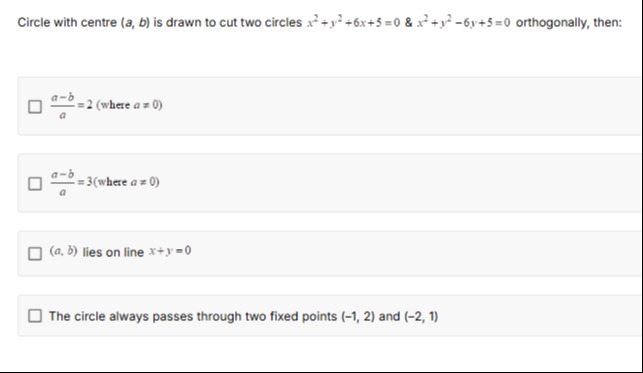Question
Question: Circle with centre $(a, b)$ is drawn to cut two circles $x^2+y^2+6x+5=0$ & $x^2+y^2-6y+5=0$ orthogon...
Circle with centre (a,b) is drawn to cut two circles x2+y2+6x+5=0 & x2+y2−6y+5=0 orthogonally, then:

aa−b=2 (where a=0)
aa−b=3 (where a=0)
(a,b) lies on line x+y=0
The circle always passes through two fixed points (−1,2) and (−2,1)
Options 1, 3, and 4 are correct.
Solution
Solution:
-
Write the equations of the given circles in center‐radius form:
-
x2+y2+6x+5=0
→ (x+3)2+y2=4 (center (−3,0), radius 2)
-
x2+y2−6y+5=0
→ x2+(y−3)2=4 (center (0,3), radius 2)
-
-
Let the circle with center (a,b) (and radius r) be orthogonal to both. The orthogonality condition is:
(distance between centers)2=r2+(given circle’s radius)2.For the first circle:
(a+3)2+b2=r2+4(1)For the second circle:
a2+(b−3)2=r2+4(2)Subtract (1) from (2):
[a2+(b−3)2]−[(a+3)2+b2]=0.Expanding and simplifying:
a2+(b2−6b+9)−(a2+6a+9+b2)=−6b−6a=0,which gives:
a+b=0orb=−a.Thus, the center (a,b) lies on the line x+y=0 [Option (3)].
-
Now, substituting b=−a into the expression aa−b:
aa−(−a)=a2a=2.So, we get aa−b=2 [Option (1)].
-
To show that the circles always pass through fixed points, express the circle with center (a,−a) and radius r:
(x−a)2+(y+a)2=r2.But from (1) (with b=−a):
(a+3)2+a2=r2+4⇒r2=(a+3)2+a2−4.Thus, the circle is:
(x−a)2+(y+a)2=(a+3)2+a2−4.For a point (x,y) to be common to all such circles (i.e. fixed), the relation must hold for all a. Writing the expanded form:
x2−2ax+a2+y2+2ay+a2=x2+y2+2a2+2a(−x+y).Since the right side is (a+3)2+a2−4=2a2+6a+5, equate the coefficients of like powers of a:
- Coefficient of a2: 2=2 (satisfied)
- Coefficient of a: 2(−x+y)=6 ⟹ y−x=3
- Constant term: x2+y2=5
Thus, the fixed points satisfy:
y=x+3andx2+(x+3)2=5.Solving:
2x2+6x+9=5⇒2x2+6x+4=0⇒x2+3x+2=0, (x+1)(x+2)=0⇒x=−1 or −2.Then, y=−1+3=2 or y=−2+3=1. Thus, the fixed points are (−1,2) and (−2,1) [Option (4)].
-
Option (2) aa−b=3 is not true since we found aa−b=2.
Explanation (Minimal):
- Given circles: (x+3)2+y2=4 and x2+(y−3)2=4.
- Using orthogonality, equate (a+3)2+b2=a2+(b−3)2 giving a+b=0 (i.e. center lies on x+y=0).
- Then, aa−b=a2a=2.
- Eliminating parameter a shows fixed points (−1,2) and (−2,1) lie on every such circle.
